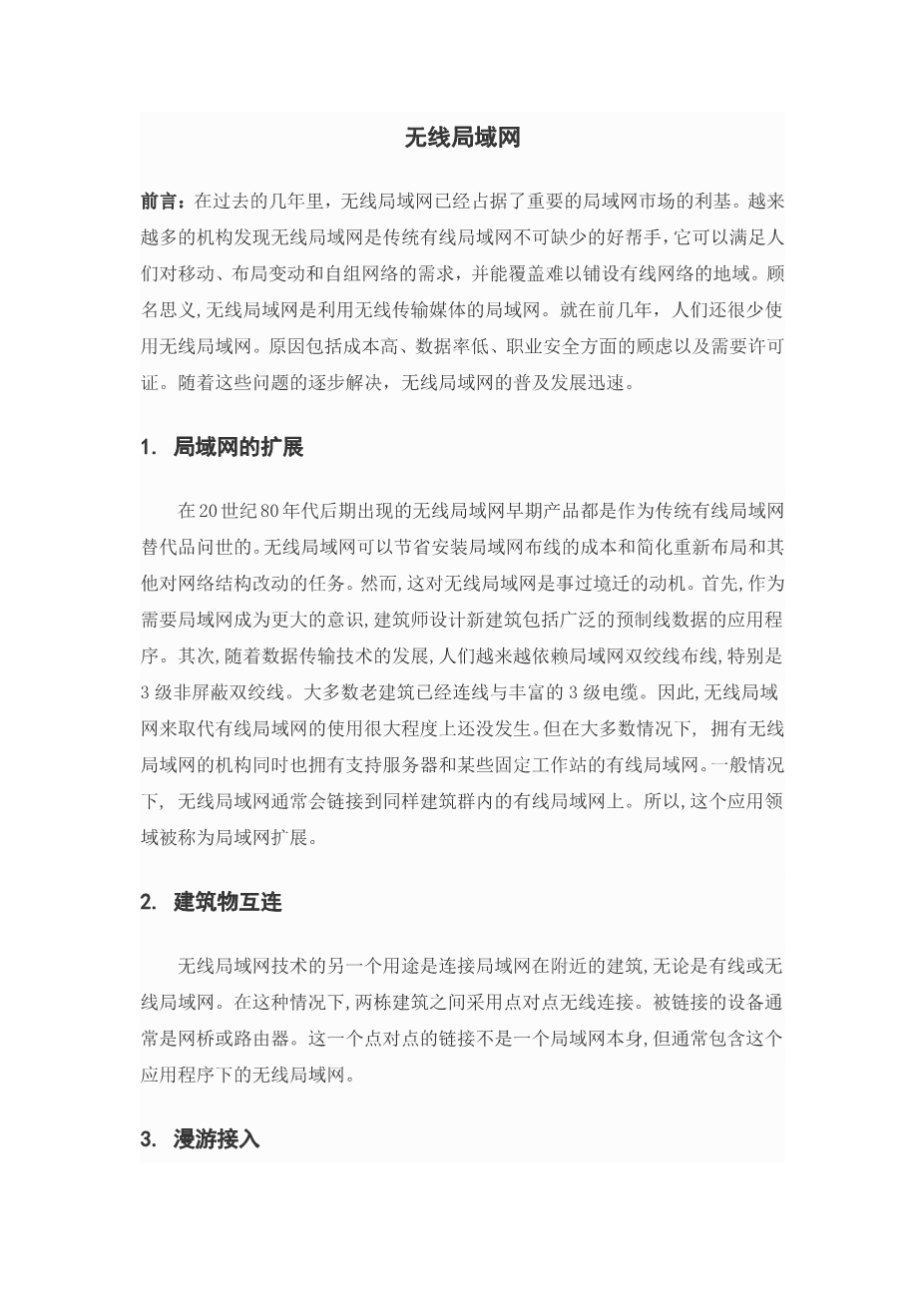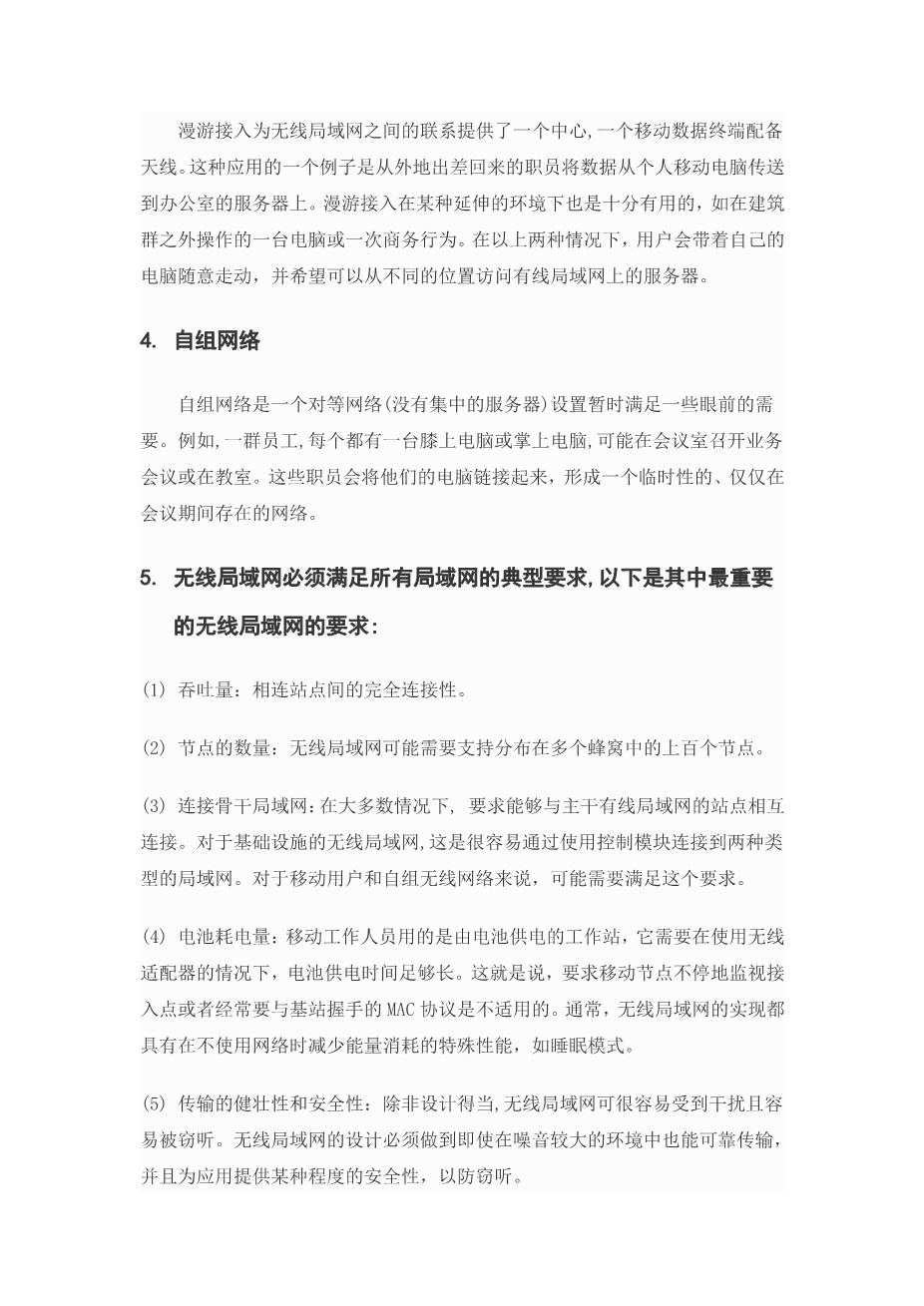WIRELESS LAN
Preface:In just the past few years, wireless LANs have come to occupy a significant niche in the local area network market. Increasingly, organizations are finding that wireless LANs are an indispensable adjunct to traditional wired LANs, as they satisfy requirements for mobility, relocation, ad hoc networking, and coverage of locationsdifficult to wire. As the name suggests, a wireless LAN is one that makes use of a wireless transmission medium. Until relatively recently, wireless LANs were little used; the reasons for this included high prices, low data rates, occupational safety concerns, and licensing requirements. As these problems have been addressed, the popularity of wireless LANs has grown rapidly.
- The expansion of the LAN
Earlywireless LAN products, introduced in the late 1980s, were marketed as substitutes for traditional wired LANs. A wireless LAN saves the cost of the installation of LAN cabling and eases the task of relocation and other modifications to network structure. However, this motivation for wireless LANs was overtaken by events. First, as awareness of the need for LAN became greater, architects designed new buildings to include extensive prewiring for data applications. Second, with advancesin data transmission technology, there has been an increasing reliance on twisted pair cabling for LANs and, in particular, Category 3 unshielded twisted pair. Mostolderbuilding are already wired with an abundance of Category 3 cable. Thus, the use of a wireless LAN to replace wired LANs has not happened to any great extent. However,In most of these cases, an organization will also have a wired LAN to support servers and some stationary workstations. Typically, a wireless LAN will be linked into a wired LAN on the same premises. Thus, this application area is referred to as LAN extension.
- Cross-Building Interconnect
Another use of wireless LAN technology is to connect LANs in nearby buildings, be they wired or wireless LANs. In this case, a point-to-point wireless link is used between two buildings. The devices so connected are typically bridges or routers. This single point-to-point link is not a LAN per se, but it is usual to include this application under the heading of wireless LAN.
- Nomadic Access
Nomadic access provides a wireless link between a LAN hub and a mobile data terminal equipped with an antenna. One example of the utility of such a connection is to enable an employee returning from a trip to transfer data from a personal portable computer to a server in the office. Nomadic access is also useful in an extended environment such as a campus or a business operating out of a cluster of buildings. In both of these cases, users may move around with their portable computers and may wish access to the servers on a wired LAN from various locations.
- Ad Hoc Networking
An ad hoc network is a peer-to-peer network (no centralized server) set up temporarily to meet some immediate need. For example, a group of employees, each with a laptop or palmtop computer, may convene in a conference room for a business or classroom meeting. The employees link their computers in a temporary network just for the duration of the meeting.
- A wireless LAN must meet the same sort of requirements typical of any LAN, The following are among the most important requirements for wireless LANs:
- Throughput.:The medium access control protocol should make as efficient use as possible of the wireless medium to maximize capacity.
- Number of nodes.:Wireless LANs may need to support hundreds of nodes across multiple cells.
- Connection to backbone LAN:In most cases, interconnection with stations on a wired backbone LAN is required. For infrastructure wireless LANs, this is easily accomplished through the use of control modules that connect to both types of LANs. There may also need to be accommodation for mobile users and ad hoc wireless networks.
- Battery power consumption.:Mobile workers use battery-powered workstations that need to have a long battery life when used with wireless adapters. This suggests that a MAC protocol that requires mobile nodestoconstantlymonitor access points or to engage in frequent handshakes with a base stationis inappropriate.
- Transmission robustness and security:Unless properly designed, a wireless LAN may be interference-prone and easily eavesdropped upon. The design of a wireless LAN must permit reliable transmission even in a noisy environment and should provide some level of security from eavesdropping.
- Collocated network operation:Aswireless LANs become more popular, it is quite likely for two of them to operate in the same area or in some area where interference between the LANs is possible. Such interference may thwart the normal operation of a MAC algorithm and may allow unauthorized access to a particular LAN.
- License-free operation.:Users would prefer to buy and operate wireless LAN products without having to secure a license for the frequency band used by the LAN.
- Switch and roaming:The MAC protocol used in the wireless LAN should enable mobile stations to move from one cell to another.
- Dynamic configuration.:The MAC addressing and network management aspects of the LAN should permit dynamic and automated addition, deletion, and relocation of end systems without disruption to other users.
- Wireless LAN Technology Wireless LANs are generally categorized according to the transmission techniquethatis used. All current wireless LAN products fall into one of the following categories:
- Infrared (IR) LANs.:An individual cell of an IR LAN is limited to a single room, as infrared light does not penetrate opaque walls.
-
Spread Spectrum LANs.:T
剩余内容已隐藏,支付完成后下载完整资料
英语译文共 9 页,剩余内容已隐藏,支付完成后下载完整资料
资料编号:[612935],资料为PDF文档或Word文档,PDF文档可免费转换为Word
课题毕业论文、外文翻译、任务书、文献综述、开题报告、程序设计、图纸设计等资料可联系客服协助查找。




